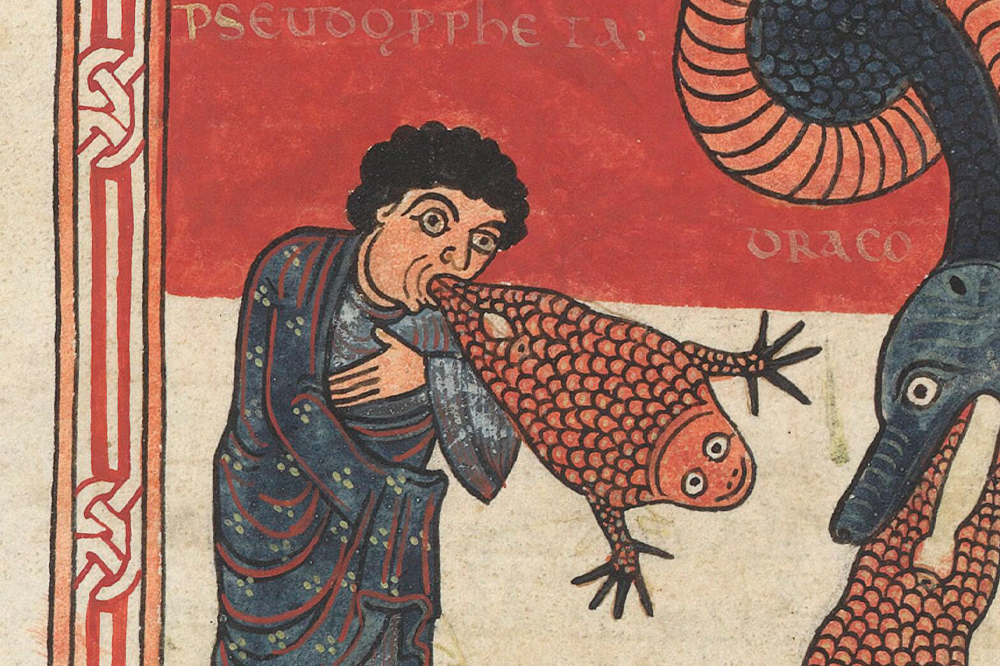Since 2019, Olivia Swarthout has been sharing the raucous, racy, ridiculous photographs that proliferate on the leaves of medieval manuscripts with an enormous social media viewers. Juxtaposing photographs of monsters, miracles and the odd anthropomorphic vegetable with dry captions, @weirdmedieval on X (previously Twitter) and @weirdmedievalguys on Instagram provide moments of astonishment and amusement amid a stream of catastrophes, outrages and cat memes. In doing so, they join an enormous variety of viewers to the extraordinary digital assets that establishments have generated over the previous 25 years or so: 1000’s of medieval manuscripts have been totally digitised and made freely obtainable (for these with the talents and willpower to seek out them) on institutional platforms around the globe. These embrace lots of the world’s largest collections, such because the Bibliothèque nationale de France, the Vatican, the Bodleian and the British Library (however extra on this final in a second).
‘Worm getting drunk, France’ – element of folio 302r of Hours of Charles the Noble, King of Navarre (c. 1405), Grasp of the Brussels Initials and Associates. Cleveland Museum of Artwork
Bizarre Medieval Guys: How you can Stay, Chortle, Love (and Die) in Darkish Occasions interprets the social media expertise into ebook type. The subtitle alludes to the rhyming of medieval and fashionable calamities (warfare, pestilence, famine, loss of life) and to the didactic underpinnings of lots of the photographs that seem in manuscripts. Even the silliest photographs (rabbits flaying a person; an owl bishop surrounded by apes) end up to have roots in biblical texts and within the exemplary tales with which medieval preachers salted their sermons, as Lilian Randall demonstrated in her landmark examine Photographs within the Margins of Gothic Manuscripts (1966).
The ebook is organised thematically, with Half 1 centered on photographs and wry commentary about life, love and loss of life. Half 2 mines the bestiary for bats, hedgehogs, mermaids and bees, with captions that mix amusingly direct descriptions (‘Boar carrying pants’) with affectionate mockery (schematically-drawn bees are ‘candy little peanuts, flying off to their well-endowed hive’). These sections are framed by photographs of the Creation firstly, and the 4 Horsemen of the Apocalypse on the finish.
‘Candy little peanuts, flying off to their well-endowed hive’ – element from folio 64v of Anonymi tractatus de quadrupedibus, de avibus et de piscibus (1301–1400), unknown artist. Bibliothèque nationale de France
Richly illustrated and frivolously written, this ebook will amuse its readers, however it will likely be as much as them to find extra concerning the contexts during which these photographs had been made. An inventory of photograph credit on the finish provides the establishment, shelf-mark and folio reference for every of the pictures, however in any other case data that may allow the curious reader to dig deeper (dates, locations of manufacturing, hyperlinks to the digitised manuscript, notes on additional studying) is absent, signalling that this a ebook for the humour shelf, not the (artwork) historical past studying listing. That is an remark, not a criticism: such publications play a helpful half within the art-history ecosystem, drawing new voices, views and audiences to materials that’s in any other case largely the protect of specialists and their college students. And who needs to be a vibe-killing bibliographer-art historian, popping up within the feed with details and corrections? In its means, Bizarre Medieval Guys follows the custom established by medieval preachers and artists themselves: laughter, surprise and just a little shock at times can spark fascination greater than solemn explanations about context and codicology (even when, in the long run, these provide extra sustaining nourishment).
‘Physician canine treating sick cat, fifteenth century’ – element of folio 25v of manuscript with shelfmark Db. 3.20, unknown artist. Edinburgh College Library
The publication of Bizarre Medieval Guys in November got here a couple of days after the cyber-attack on the British Library that has taken down its web site – and with it, the entire catalogues and digitised manuscripts on which this ebook and its related social media feeds have been closely reliant. Disruption to the British Library’s digital property is anticipated for months to come back. In the meantime, the transformation of Twitter into X has resulted in a palpable diminution of engagement from the communities that after gathered there to share observations and questions on medieval manuscripts. These disruptions underscore the ephemeral nature of the digital medieval manuscript. A parchment manuscript can survive in terribly good situation for greater than a thousand years, however will its digital surrogate be obtainable from in the future to the following? From this angle, the phenomenon of the social media account materialising as a printed ebook marks an enchanting shift that echoes first the late vintage transfer from roll to codex, and the return to scrolling – this time on display screen slightly than on papyrus or parchment – from the mid Nineteen Nineties. Are we witnessing the tide turning again from scroll to codex? Simply as libraries around the globe have come to depend on digital facsimiles as surrogates for medieval manuscripts, this publication gestures in direction of a time after we will depend upon the printed ebook as proof of an evanescent social media feed.
Bizarre Medieval Guys: How you can Stay, Chortle, Love (and Die) in Darkish Occasions by Olivia Swarthout is printed by Sq. Peg.
